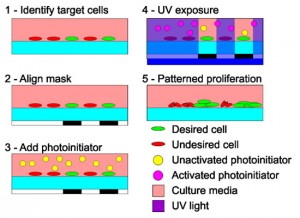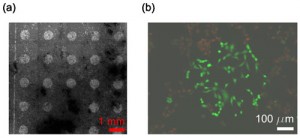Image-based Cell Sorting
This research involves the development of architectures for screening complex phenotypes in biological cells. We augment microscopy with the ability to retrieve cells of interest. This capability will permit cell isolation on the basis of dynamic and/or intracellular responses, enabling new avenues for screening. Currently, such sorts require expensive specialized equipment, widely prohibiting such sorts.
We previously reported a technique for selective hydrogel-based photoencapsulation of undesired cells in cell cultures to enable sorting [1]. We have increased the resolution of this technique, improving purification and enrichment performance. We have also adapted this approach into an even simpler technique that permits sorting via photopatterned free-radical toxicity termed radical-activated cell sorting, or RACS [2] (Figure 1). Here we plate adherent cells into a dish, assay them using microscopy, and note the positions of cells of interest. We then use an inexpensive inkjet printer to print a transparency mask with opaque features corresponding to locations of cells of interest. After we align the mask to the dish, features reside beneath target cells. We then add a solution to the dish containing a UV-photoinitiator. We expose the dish through the mask with UV light, which causes the photoinitiator to split into toxic radicals that attack and kill unmasked, undesired cells, leaving behind live, desired cells (Figure 2). The method permits culture on arbitrary substrates and requires standard hardware found in biology labs and an inexpensive photoinitiator, facilitating dissemination.
We have demonstrated the ability to pattern viability with resolution < 500 μm as well as the functional sorting of mixed MCF7 cell cultures predicated on microscopy-based selection. Further development will increase the range of cell types that can be sorted using this technique and resolution. The straightforward operation and low cost of RACS will especially appeal to biologists, bringing straightforward image-based cell-sorting technology to individual labs.
- Figure 1: Operation of RACS. 1-Microscopy is used to identify target cells. 2-Mask is aligned to dish underside. 3-Photoinitiator-containing media is added. 4-Mask-patterned UV light radicalizes photoinitiator in unmasked regions; radicals attack cells. 5-Exposed cells die; masked cells survive and proliferate.
- Figure 2: Photopatterned viability. (a) Live/dead staining of a monolayer of cells following RACS performed with a mask consisting of an array of circular features; dead cells stain dark. (b) Detail of live/dead staining of a monolayer of cells following RACS exposure using a circular mask feature; live cells stain green, and dead cells stain red.
References
- J.R. Kovac and J. Voldman, “Microscopy-based sorting of adherent cells using photopolymerization-activated cell sorting (PACS),” presented at the Biomedical Engineering Society Annual Meeting, St. Louis, MO, 2008. [↩]
- J.R. Kovac and J. Voldman, “Facilitated, Image-based Clonal Selection Using Radical-Activated Cell Sorting (RACS),” presented at the Biomedical Engineering Society Annual Meeting, Pittsburgh, PA, 2009. [↩]

